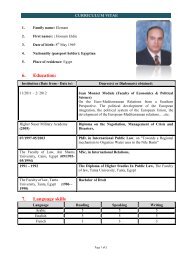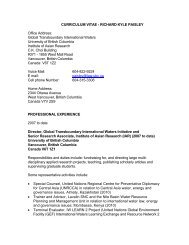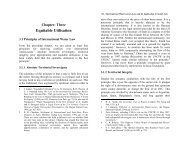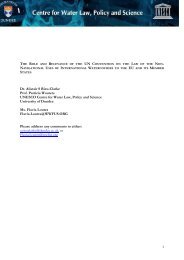Upreti, Trilochan, International Watercourses Law and Its Application ...
Upreti, Trilochan, International Watercourses Law and Its Application ...
Upreti, Trilochan, International Watercourses Law and Its Application ...
Create successful ePaper yourself
Turn your PDF publications into a flip-book with our unique Google optimized e-Paper software.
186 / <strong>International</strong> <strong>Watercourses</strong> <strong>Law</strong> <strong>and</strong> <strong>Its</strong> <strong>Application</strong> in South Asia Prospects <strong>and</strong> Problems of Nepalese Water Resources / 187water during the dry season, hydroelectric power, <strong>and</strong> floodcontrol during the wet season, are absolutely essentialrequirements to India <strong>and</strong> Bangladesh. 20Besides this, fundamental benefits could accrue to Nepal aswell, in particular from co-operation over navigationalfacilities, giving access to <strong>and</strong> from the sea, an essentialrequirement so that Nepal can diversify her trade in a morecompetitive way. 21 Nepal had repeatedly called for such access,which she is entitled to by international law, but of which shehas been deprived. In order to maximise the benefits, anintegrated <strong>and</strong> holistic approach needs to be undertaken inNepal, for example in watershed management, <strong>and</strong> afforestationin the Siwalik <strong>and</strong> the hills of the Himalayas, which wouldsignificantly reduce the silt <strong>and</strong> sediment that causestremendous loss <strong>and</strong> damage to territory downstream. As aresult of this approach, all nations involved would benefit. 22 Anexample of this is the Indo-Bhutan co-operation in the Chukhaproject, which enormously benefited both nations. 23Additionally, there are several projects under review forimplementation. Primarily, these are the hydroelectric projects:(1,020 MW) the Tala Project on the Wangchu downstream ofChukha, the Chukha II, the Sunkosh High Dam Project (1525MW), the Chukha III (900 MW) <strong>and</strong> the Mannes High Dam20 B. G. Vergeese & R. R. Iyer (eds), Harnessing the Eastern HimalayanRivers: Regional Co-operation in South Asia, New Delhi: KonarkPub., 1994, p. 267.21 C. K. Sharma, Water <strong>and</strong> Energy Resources of the Himalayan Block,Kathm<strong>and</strong>u: Sangita Sharma, 1983, p. 377.22 B. G. Vergeese, Waters of Hope, New Delhi: Oxford & IBH Pub.,1990, p. 347.23 Supra note 17. pp 199-200: the 336 MW hydropower project jointlyundertaken by means of Indo-Bhutan co-operation provides a goodexample, in which India provided 40% of the project cost as assistanceto Bhutan <strong>and</strong> the remaining 60% as an investment on 50/50 ownershipof the joint investment project. The electricity generated is beingexported to India as a result of which a huge amount of money, 40crore annually, has accrued to Bhutan as revenue from which hereconomy has benefited.project (2800 MW), <strong>and</strong> apart from these India’s strategy todivert the Brahamputra into any or all of the Torsa, Raidak, theSunkosh <strong>and</strong> Manes rivers in Bhutan, schemes which are underdiscussion. 24 Due to the income of Chukha I, a 336 MWproject, <strong>and</strong> other projects in the pipeline, Bhutan is emergingas one of the wealthiest nations, in terms of per capita income,in south Asia. 25 Such cooperative arrangement for the mutualbenefits of India <strong>and</strong> Nepal is the need of the hour <strong>and</strong> fromsuch cooperation other nation also could benefit.4. 3 History of Water Resource Development:Indo-Nepal RelationsNepal's water resource development dates back to the Exchangeof Letters of 1920 with the then British Government in Indiaregarding the construction <strong>and</strong> operation of the Sarada BarrageProject. This was the first international agreement in thesubcontinent in modern time. 26 Through the Exchange ofLetters of 1920, Nepal agreed to transfer 4093.88 acres of herl<strong>and</strong> on the east bank of the Mahakali river to India so thatIndia could build the Sarada Barrage across the river to regulatethe waters for irrigation. In exchange for the l<strong>and</strong>, Nepalreceived an equal amount of l<strong>and</strong> elsewhere. In addition, Indiaagreed to provide Nepal with a supply of 460 cusses of water<strong>and</strong>, provided the surplus was available, a supply of up to 1000cusses from the Sarada canal should cultivation exp<strong>and</strong> at anytime in the future. 27 This project was initially undertaken toprovide irrigation facilities in the Indian state of Uttar Pradesh24 B. Subba, “Tapping Himalayan Water Resources: Problems,Opportunities <strong>and</strong> Prospects from a Bhutanese Perspective” (1994) in 4Water Nepal, p. 210; also see R. S. Kharat, Bhutan in SAARC: Role ofa Smaller State in a Regional Alliance, New Delhi: South Asian Pub.,1999, pp. 97-99.25 B. Subba, Himalayan Waters, Katm<strong>and</strong>u: Panos south Asia, 2001, p.204.26 N. D. Gulhati, Development of Inter-State Rivers: <strong>Law</strong> <strong>and</strong> Practicesin India, New Delhi: Allied Pub., 1982, p. 166.27 Supra note 20, p. 201.












